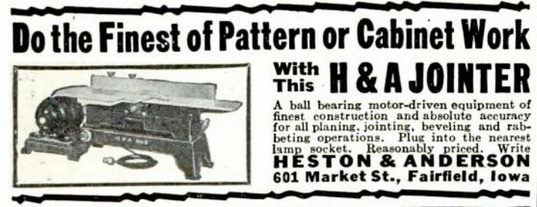In 1915 two young men, Lorenzo R. Heston and Abner L. Anderson, were employed as draftsman and pattern maker, respectively, at agricultural equipment maker Louden Machinery Co. The two men worked together to improve their skills, and they undertook to design an iron shaper and then build an example. Needing a bandsaw to construct the patterns for the shaper, they fabricated one using material such as gas pipe and gears from a washing machine. This bandsaw worked well and they ultimately sold it to a local contractor/builder. World War I intervened and both Heston and Anderson enlisted and then served in the war.
After the war ended the two resumed their efforts, but they switched their focus to designing a more refined bandsaw that they could manufacture themselves. At first they worked out of Heston's basement, where they completed the design and made the patterns. In 1921 they formally established their partnership, Heston & Anderson, and began production of the bandsaw. Over the next three or so years they manufactured 2000 saws, employing three men. During this time Heston, at least, was still employed at Louden's.
By 1925 it was obvious that their business was a success and was ready to expand. Heston resigned from Louden's, they bought land at Sixth and Depot streets in Fairfield, and built a 30x60 factory and office. The following year they erected a second building of the same size and in 1927 they put in a 30x30 addition. In 1929 they built new premises on Kirkwood St., with 30x70 office and 50x115 factory. This building would be their home for the remainder of the business's existence. Their sales were through a separate entity called Blue Star Products. Heston & Anderson products have also been seen labeled W. W. Grainger, a large industrial supply company.

Advertisement from the January 1930 "Popular Mechanics"
Heston & Anderson's product line consisted primarily of home-shop machinery: 4-inch and 6-inch jointers, 10-inch tablesaws, 12-inch and 14-inch bandsaws, etc. One of their most successful products was a swing saw aimed at small sawmills and lumberyards. In the late 1920s and early 1930s their 12-inch bandsaw was sold by Delta Specialty Co. as the Delta No. 385.
The first half of the 20th century saw a tremendous growth in the sales of home shop machinery. Heston & Anderson had good products but were not ideally located to take advantage of the growing market, and they likely did not have the financial resources to fund aggressive expansion. Competitors like Delta, Walker-Turner, Atlas Press and Duro captured the lion's share of the market. Nevertheless, Heston & Anderson remained modestly successful into the 1940s.
Lorenzo Heston died of a heart attack in June 1944, and shortly afterward the business was sold to St. Paul Foundry & Manufacturing Co. The Heston & Anderson name was retained and the business was operated as a division of the St. Paul company. Abner Anderson continued to work for Heston & Anderson as a development engineer. He died of a heart attack in December 1947.
The business survived until at least 1969 but eventually disappeared, after years of shrinking sales. Heston & Anderson is long gone: parts and service are no longer available. An exception was their swing saw, which remained in production until the 2010s via H & A Swing Saw Inc.
Information Sources
- Genealogy website Jefferson County Online provides several useful resources:
- 1932 catalog, no. 4-H; catalog no. 11 with 1934 and 1935 price lists.
- Ad in January 1949 issue of The Carpenter, featuring their 8" tilting arbor saw.
- A 1952 tablesaw patent was granted to Abner L. Anderson and assigned to St. Paul Foundry & Manufacturing Co.
- Ad in 1955-56 Hitchcock's Wood-Workers' Digest Directory, which says, "Division of St. Paul Foundry & Mfg. Co." Tools were aimed at the light-duty professional and the serious amateur market.
- St. Paul Foundry & Manufacturing Co. was assigned a (non-woodworking) 1969 patent.
- The W. W. Grainger connection was established in a posting to an owwm.org forum.
- An owwm.org forum post provides information and photographs on this company's building in Fairfield.